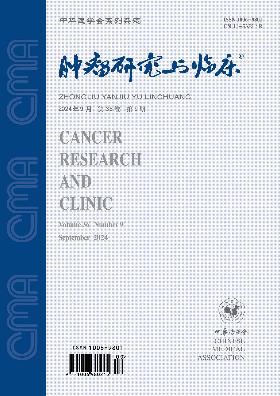Initial analysis of human papilloma virus for patients with head and neck squamous cell carcinoma in a single center in Chaoshan area of Guangdong Province
Q4 Medicine
引用次数: 0
Abstract
Objective To detect the infection and subtype status of human papilloma virus (HPV) for patients with head and neck squamous cell carcinoma (HNSCC) treated in a single center in Chaoshan area of Guangdong Province. Methods The primary lesion samples from 167 HNSCC patients in Cancer Hospital of Shantou University Medical College between December 2014 and December 2016 were collected. The expression of p16 protein in tumor tissues was detected by using immunohistochemistry (IHC), and the positive rate of tumor cell p16 protein≥ 76% was used as a diagnostic standard to judge HPV in HNSCC; the relationship between p16 protein and the clinicopathological factors was analyzed. The status of HPV 16/18 DNA in tumor tissues was tested by using in situ hybridization(ISH). RNA scope was used to detect the RNA expression of 18 kinds of common high-risk HPV subtype (HPV HR 18), and the positive status of HPV HR 18 in tumor tissues with the positive cell proportion ≥ 50% of p16 protein was analyzed. Results The strong expression rate of p16 protein was 7.2% (12/167). The strong expression rate of p16 protein in the younger group ( 0.05). HPV 16/18 DNA was not found in all HNSCC primary lesions by using ISH, which showed the same result after repeated examination. RNAscope method showed that 3 cases (15.8%) out of the 19 patients with p16 protein positive rate≥50% were HPV HR 18 RNA positive. Conclusions The positive rate of HPV for HNSCC patients in Chaoshan area is low, while the patients with oropharyngeal carcinoma have the highest rate and tend to be younger. The main carcinogenic viruses of HPV for HNSCC patients in Chaoshan area are other subtypes of HPV including HPV HR 18 rather than HPV 16/18. Key words: Head and neck neoplasms; Carcinoma, squamous cell; Human papillomavirus; Chaoshan area广东潮汕地区某中心头颈部鳞状细胞癌患者人乳头状瘤病毒的初步分析
目的了解广东潮汕地区头颈部鳞状细胞癌(HNSCC)患者中人乳头状瘤病毒(HPV)的感染及亚型状况。方法收集汕头大学医学院癌症医院2014年12月至2016年12月收治的167例HNSCC患者的原发灶标本。应用免疫组织化学(IHC)检测肿瘤组织中p16蛋白的表达,以肿瘤细胞p16蛋白阳性率≥76%作为判断HNSCC中HPV的诊断标准;分析p16蛋白与临床病理因素的关系。应用原位杂交(ISH)技术检测HPV16/18DNA在肿瘤组织中的表达情况。应用RNA镜检测18种常见高危型HPV亚型(HPV HR 18)的RNA表达,分析p16蛋白阳性细胞比例≥50%的肿瘤组织中HPV HR 18的阳性状态。结果p16蛋白的强表达率为7.2%(12/167)。p16蛋白在年轻组中的强表达率(0.05)。ISH未在所有HNSCC原发性病变中发现HPV 16/18 DNA,重复检查后显示相同的结果。结果:19例p16蛋白阳性率≥50%的患者中,有3例(15.8%)为HPVHR18RNA阳性。结论潮汕地区HNSCC患者HPV阳性率较低,口咽癌患者阳性率最高,且有年轻化趋势。潮汕地区HNSCC患者HPV的主要致癌病毒是其他亚型的HPV,包括HPVHR18而不是HPV16/18。关键词:头颈部肿瘤;癌,鳞状细胞;人乳头瘤病毒;潮汕地区
本文章由计算机程序翻译,如有差异,请以英文原文为准。
求助全文
约1分钟内获得全文
求助全文
来源期刊

肿瘤研究与临床
Medicine-Oncology
CiteScore
0.10
自引率
0.00%
发文量
7737
期刊介绍:
"Cancer Research and Clinic" is a series of magazines of the Chinese Medical Association under the supervision of the National Health Commission and sponsored by the Chinese Medical Association.
It mainly reflects scientific research results and academic trends in the field of malignant tumors. The main columns include monographs, guidelines and consensus, standards and norms, treatises, short treatises, survey reports, reviews, clinical pathology (case) discussions, case reports, etc. The readers are middle- and senior-level medical staff engaged in basic research and clinical work on malignant tumors.
 求助内容:
求助内容: 应助结果提醒方式:
应助结果提醒方式:


